Experimental Study on Sandwich Composites with Carbon Fiber Fabric Skin and 3D-Printed Carbon Fiber-Reinforced Polyamide Core
Abstract
1. Introduction
- a.
- The proposed sandwich structure, consisting of a carbon fiber fabric/epoxy resin skin and a 3D-printed PAHT-CF core, prepared using the hand lay-up technique, has not yet been experimentally benchmarked in the literature, to the best of the authors’ knowledge.
- b.
- A series of different tests has been conducted, including tensile, three-point bending, impact, hardness, density, and water absorption, providing a comprehensive view of the most important properties, often required in a variety of engineering applications.
- c.
- Although the effect of the cubic infill pattern on the properties of FDM 3D-printed samples has been investigated in the literature, it has not been studied for PAHT-CF material, to the authors’ knowledge. In this work, a preliminary investigation was conducted to evaluate three infill patterns in terms of mechanical strength and dimensional accuracy.
- d.
- The outcomes of this work highlight the suitability of the proposed sandwich composites as lightweight, high-strength, and water-resistant structures for relevant applications.
2. Materials and Methods
2.1. Materials
2.2. Fabrication Process
2.3. Testing Methods
3. Results and Discussion
3.1. Preliminary Evaluation of Infill Patterns for 3D-Printed PAHT-CF Specimens
3.1.1. Mechanical Properties
3.1.2. Dimensional Accuracy and Surface Quality
3.1.3. Infill Pattern Considerations
3.2. Experimental Investigation of the Performance of the Fabricated Specimens
3.2.1. Density and Water Absorption Measurements
3.2.2. Hardness Measurements
3.2.3. Tensile Strength
3.2.4. Impact Strength
3.2.5. Flexural Strength
3.2.6. Consideration of Quality-Related Issues
3.2.7. Influence of Process Parameters on Mechanical Performance
4. Conclusions
- The results obtained in the preliminary evaluation (Section 3.1) indicate that the infill pattern significantly affects the tensile and impact strength of 3D-printed parts. Of the three examined infill patterns, i.e., lines, concentric and cubic, the concentric pattern should be preferred for structures where tensile strength is critical (e.g., arms or beams), while the cubic pattern is more suitable for structures subjected to non-uniform loading.
- The PAHT-CF core material enhanced the overall tensile strength and stiffness of the sandwich structure. This improvement is attributed to the high strength chopped carbon fibers embedded in the polyamide matrix, oriented along the deposition beads, that increase resistance to crack propagation and reduce the likelihood of failure.
- The CFF skin (carbon fiber fabric in epoxy resin) exhibits high mechanical strength and enhances the overall flexural strength and impact toughness of the fabricated sandwich composites. The reduced water absorption of the sandwich composites is mainly due to the water resistance of the epoxy resin and depends also on the skin thickness, which hinders water ingress into the cellular cubic core.
- PAHT-CF is easy to process via 3D printing, provided that sufficient print tests have been conducted to ensure the interaction between printing parameters and final properties. Since temperature and humidity affect the results, using a closed chamber to maintain stable conditions during 3D printing is recommended.
- The proposed fabrication process, combining 3D printing of the core and hand lay-up technique, is relatively slower than other methods for sandwich structures, such as compression molding or advanced 3D printing that integrates core and skin fabrication. Therefore, it is more suitable for small-scale or customized products.
- For larger sandwich structures, the limited build volume of FDM 3D printers can be addressed by dividing the core into smaller parts. The hand lay-up technique can then be used to gradually attach the carbon fiber fabric and join all parts with epoxy adhesive.
Supplementary Materials
Author Contributions
Funding
Data Availability Statement
Conflicts of Interest
Appendix A
| Ref., Year | Material | Infill Pattern | Printing Parameters | Properties | Outcomes |
|---|---|---|---|---|---|
| [58], 2019 | PA6, Onyx | rectangular, triangular | Variation in infill density (10%, 70%) | tensile strength at break, elastic modulus | The triangular pattern provided better tensile performance, as there were more strands oriented in the direction of load. |
| [44], 2019 | PLA-CF | cubic, cubic subdivision, quarter cubic | Variation in extrusion temperature and layer height (0.1 mm, 0.2 mm, 0.3 mm) | tensile strength | Tensile strength was mainly affected by layer height, followed by extrusion temperature and infill pattern. The highest tensile strength was obtained for the cubic pattern at 0.1 mm layer height and 225 °C extrusion temperature. |
| [45], 2020 | PLA, PLA-CF | triangles, rectilinear, lines, honeycomb | 0.2 mm layer height; Variation in infill density (20%, 40%, 60%, 80%) | compressive modulus, energy absorption capability | For PLA, the highest compressive modulus was obtained for the honeycomb pattern at 80% infill density, followed by triangle. For PLA/CF, the highest compressive modulus was obtained for the triangle pattern at 80% infill density, followed by honeycomb. |
| [16], 2021 | PLA-CF | cubic, triangles, tri-hexagonal | Variation in layer height (0.1 mm, 0.2 mm, 0.3 mm), infill density (40%, 60%, 80%), printing speed | tensile and flexural strength | The tri-hexagonal pattern provided higher tensile and flexural strength, followed by triangles and cubic. The highest tensile and flexural strength was obtained for the tri-hexagonal pattern at 0.3 mm layer height and 80% infill density. |
| [20], 2022 | PLA-CF | grid, triangular, tri-hexagonal | 0.2 mm layer height; Variation in print speed, infill density (50%, 75%, 100%), nozzle temperature | impact Izod strength, hardness, dimensional accuracy | The maximum impact strength was obtained for the grid pattern at 75% infill density and 240 °C nozzle temperature. The highest hardness value was obtained for tri-hexagonal pattern at 75% infill density and for the grid and triangular patterns at 100% infill density. |
| [18], 2022 | PAHT-CF | grid, lines, triangles | 0.2 mm layer height; 50% infill density | bending and tensile strength | Tensile strength was found higher for the lines pattern followed by triangles and grid. Bending strength was found higher for triangles followed by lines and grid. Defects decreased from grid pattern to lines pattern while they were insignificant for the triangles pattern. |
| [17], 2022 | Nylon-CF, PLA, ABS | tridimensional, hexagonal, linear | Variation in infill density (33%, 66%, 100%) | ultimate tensile stress, young’s modulus | For Nylon-CF, the higher tensile strength was obtained for tridimensional pattern, followed by hexagonal and linear, regardless of the infill density. |
| [59], 2023 | PA6-CF20, PA6-CF25 | triangular, hexagonal, kagome, re-entrant | 0.15 mm layer height; 100% infill density; variation in raster angle | energy absorption capability | The kagome honeycomb pattern provided the highest specific energy absorption, with a value comparable to that of metals. |
| [60], 2024 | PLA-CF | lines, gyroid | Variation in infill density (50%, 75%, 100%) | bending strength | Specimen with the lines pattern exhibited a higher maximum load compared to gyroid pattern at 75% and 100% infill densities, indicating higher toughness. |
| [19], 2024 | PA6 CF-GF | concentric, grid, honeycomb | 0.25 mm layer height, 50% infill density for honeycomb and grid, 100% infill density for concentric and grid | compression strength, modulus, yield, and strain at peak | For 50% infill density, the grid pattern provided higher compression strength compared to honeycomb. For 100% infill density, the concentric pattern provided the highest compression strength and superior compression modulus. The highest peak deformation was observed for the grid pattern at 100% density. |
| [61], 2024 | PETG, PETG-CF | hexagonal, triangles, linear | 0.2 mm layer height; Variation in infill density (30%, 60%, 100%) | tensile strength young’s modulus, nominal strain at break | For both PETG and PETG-CF, the hexagonal pattern provided the highest tensile strength. The linear pattern provided the highest young’s modulus indicating rigidity, but also lower ductility. |
| Ref., Year | Core Structure | Core Material | Skin Material | Tests |
|---|---|---|---|---|
| [51], 2021 | honeycomb, re-entrant, pyramid, hierarchical pyramid and gyroid | PA12 | CFRP | three-point bending test |
| [50], 2022 | honeycomb at 20% infill density | PLA, PC | GFRP for PLA, CFRP for PC | bending rigidity |
| [62], 2022 | honeycomb with three levels of hierarchy | PLA | fiberglass reinforced starch-based skin | three-point bending test |
| [63], 2023 | honeycomb with altering layers at 30% and 100% infill density | PP | CFRP | low-velocity impact test |
| [64], 2023 | hexagonal honeycomb at 100% density varying unit cell sizes | PLA, PLA-CF, PLA-wood | CFRP | low-velocity impact test |
| [7], 2023 | twelve 2D and seven 3D cellular cores | PEI Ultem® | CFRP | three-point bending test |
| [65], 2024 | double arrowhead auxetic | PLA | carbon-aramid composite sheets | compression and vibration tests |
| [66], 2024 | gyroid at 10%, 15% and 20% infill density (PU foam into core cavities) | PLA | CFRP | flexural and compression tests |
| [67], 2024 | rectangular corrugated (PU foam into core cavities) | PA6-CF20%, PA6-GF25% | GFRP | quasi-static indentation test |
| [68], 2024 | TPMS non-uniform gyroid | ASA | tempered glass | three-point bending test |
| [69], 2025 | grid, cross3D and lightning at 20% density | PLA | GFRP | low-velocity impact test |
| [49], 2025 | Hexagonal, tri-hexagonal, triangles, at 10% and 100% density | PLA | GFRP | tensile properties |
| [70], 2025 | truss-type structure | PLA, balsa, PVC foam | flax fiber fabric | three-point bending test |
| [71], 2025 | triangular, hexagonal and trihexagonal at 40% infill density | PLA-GF16% | layers of aluminum and Kevlar fiber | low-velocity impact test |
| [72], 2025 | honeycomb | PLA | CFRP or GFRP | compression and bending test |
| [57], 2025 | honeycomb, x-shape, tubular hollow, triangular, tubular solid | PLA | CFRP | three-point bending test |
| ||||
References
- Rubino, F.; Nisticò, A.; Tucci, F.; Carlone, P. Marine Application of Fiber Reinforced Composites: A Review. J. Mar. Sci. Eng. 2020, 8, 26. [Google Scholar] [CrossRef]
- Mishra, P.K.; Jagadesh, T. Applications and Challenges of 3D Printed Polymer Composites in the Emerging Domain of Automotive and Aerospace: A Converged Review. J. Inst. Eng. India Ser. D 2022, 104, 849–866. [Google Scholar] [CrossRef]
- Hamzat, A.K.; Murad, S.; Adediran, I.A.; Asmatulu, E.; Asmatulu, R. Fiber-reinforced composites for aerospace, energy, and marine applications: An insight into failure mechanisms under chemical, thermal, oxidative, and mechanical load conditions. Adv. Compos. Hybrid. Mater. 2025, 8, 152. [Google Scholar] [CrossRef]
- Zhao, T.; Yang, J.; Chen, J.; Guan, S. Review of carbon fiber-reinforced sandwich structures. Polym. Polym. Compos. 2022, 30, 09673911221098729. [Google Scholar] [CrossRef]
- Feng, Y.; Hao, Q.; Yicong, G.; Hao, Z.; Jianrong, T. Creative design for sandwich structures: A review. Int. J. Adv. Robot. Syst. 2020, 17, 1729881420921327. [Google Scholar] [CrossRef]
- Wu, Y.; Fang, J.; Wu, C.; Li, C.; Sun, G.; Li, Q. Additively manufactured materials and structures: A state-of-the-art review on their mechanical characteristics and energy absorption. Int. J. Mech. Sci. 2023, 246, 108102. [Google Scholar] [CrossRef]
- Forés-Garriga, A.; Gómez-Gras, G.; Pérez, M.A. Lightweight hybrid composite sandwich structures with additively manufactured cellular cores. Thin-Walled Struct. 2023, 191, 111082. [Google Scholar] [CrossRef]
- Krajangsawasdi, N.; Blok, L.G.; Hamerton, I.; Longana, L.; Woods, B.K.S.; Ivanov, D.S. Fused Deposition Modelling of Fibre Reinforced Polymer Composites: A Parametric Review. J. Compos. Sci. 2021, 5, 29. [Google Scholar] [CrossRef]
- Cuan-Urquizo, E.; Guerra, S.R. Fused Filament Fabrication of cellular, lattice and porous mechanical metamaterials: A review. Virtual Phys. Prototyp. 2023, 18, e2224300. [Google Scholar] [CrossRef]
- Feng, J.; Fu, J.; Yao, X. Triply periodic minimal surface (TPMS) porous structures: From multi-scale design, precise additive manufacturing to multidisciplinary applications. Int. J. Extrem. Manuf. 2022, 4, 022001. [Google Scholar] [CrossRef]
- UltiMaker Cura Infill Settings. Available online: https://support.ultimaker.com/s/article/1667411002588 (accessed on 17 July 2025).
- Ma, Q.; Rejab, M.; Song, Y.; Zhang, X.; Hanon, M.M.; Abdullah, M.; Kumar, A.P. Effect of infill pattern of polylactide acid (PLA) 3D-printed integral sandwich panels under ballistic impact loading. Mater. Today Commun. 2024, 38, 107626. [Google Scholar] [CrossRef]
- Garg, S.; Singh, A.; Murtaza, Q. Measuring the Impact of Infill Pattern and Infill Density on the Properties of 3D-Printed PLA via FDM. J. Mater. Eng. Perform. 2025, 34, 22597–22610. [Google Scholar] [CrossRef]
- Akhoundi, B.; Behravesh, A.H. Effect of Filling Pattern on the Tensile and Flexural Mechanical Properties of FDM 3D Printed Products. Exp. Mech. 2019, 59, 883–897. [Google Scholar] [CrossRef]
- Wickstrom, S. Mastering 3D Printing Infill Patterns: From Gyroid to Lightning. Available online: https://ultimaker.com/learn/mastering-3d-printing-infill-patterns-from-gyroid-to-lightning/ (accessed on 17 July 2025).
- Mishra, P.K.; Senthil, P.; Adarsh, S.; Anoop, M.S. An investigation to study the combined effect of different infill pattern and infill density on the impact strength of 3D printed polylactic acid parts. Compos. Commun. 2021, 24, 100605. [Google Scholar] [CrossRef]
- Rodríguez-Reyna, S.L.; Mata, C.; Díaz-Aguilera, J.H.; Acevedo-Parra, H.R.; Tapia, F. Mechanical properties optimization for PLA, ABS and Nylon + CF manufactured by 3D FDM printing. Mater. Today Commun. 2022, 33, 104774. [Google Scholar] [CrossRef]
- Pop, M.A.; Zaharia, S.M.; A Chicos, L.; Lancea, C.; Stamate, V.M.; Buican, G.R.; Pascariu, I.S. Effect of the infill patterns on the mechanical properties of the carbon fiber 3D printed parts. IOP Conf. Ser. Mater. Sci. Eng. 2022, 1235, 012006. [Google Scholar] [CrossRef]
- Andreozzi, M.; Bianchi, I.; Forcellese, A.; Mancia, T.; Mignanelli, C.; Simoncini, M. Effect of infill percentage and pattern on compressive behavior of FDM-printed GF-CF PA6 composites. Mater. Res. Proc. 2024, 41, 283–289. [Google Scholar] [CrossRef]
- Ansari, A.A.; Kamil, M. Izod impact and hardness properties of 3D printed lightweight CF-reinforced PLA composites using design of experiment. Int. J. Lightweight Mater. Manuf. 2022, 5, 369–383. [Google Scholar] [CrossRef]
- Periasamy, K.; Bhanumurthy, R.; Viswanathan, R.; Rathore, G.; Raif, A.M.; Naveen, V.; Gurupada, J.S. Additive Manufacturing of Honeycomb Core Sandwich Panels: An Evaluation of Flexural Performance. J. Phys. Conf. Ser. 2024, 2925, 012004. [Google Scholar] [CrossRef]
- Marchese, S.S.; Epasto, G.; Crupi, V.; Garbatov, Y. Feasibility study on additive-manufactured honeycomb sandwich structural solutions for a Fast Patrol Vessel. Compos. Struct. 2025, 351, 118607. [Google Scholar] [CrossRef]
- Silva, R.G.; Pavez, G.M. Flexural characteristics of additively manufactured continuous fiber-reinforced honeycomb sandwich structures. Compos. Part C Open Access 2025, 16, 100563. [Google Scholar] [CrossRef]
- Ultrafuse® PAHT CF15 TDS. Available online: https://forward-am.com/wp-content/uploads/2024/10/Ultrafuse_PAHT_CF15_TDS_EN_v3.5-1.pdf (accessed on 17 July 2025).
- ISO 527; Plastics—Determination of Tensile Properties. International Organization for Standardization: Geneva, Switzerland, 2019.
- ISO 178; Plastics—Determination of Flexural Properties. International Organization for Standardization: Geneva, Switzerland, 2019.
- ISO 180; Plastics—Determination of Izod Impact Strength. International Organization for Standardization: Geneva, Switzerland, 2023.
- Carbon Fiber Fabrics, Formosa Taffeta Co., Ltd. Available online: https://www.ftc.com.tw/newftc/doc/FTC_Carbon_Fiber_Catalogue.pdf (accessed on 21 October 2025).
- Full General Datasheet, PDS-PRIME 37 A3X -09-0922. Available online: https://kevra.fi/wp-content/uploads/PRIME-37.pdf (accessed on 21 October 2025).
- ASTM D638; Standard Test Method for Tensile Properties of Plastics. ASTM International: West Conshohocken, PA, USA, 2022.
- ASTM D790; Standard Test Methods for Flexural Properties of Unreinforced and Reinforced Plastics and Electrical Insulating Materials. ASTM International: West Conshohocken, PA, USA, 2017.
- Dimitrellou, S.; Iakovidis, I.; Psarianos, D.R. Mechanical Characterization of Polylactic Acid, Polycarbonate, and Carbon Fiber-Reinforced Polyamide Specimens Fabricated by Fused Deposition Modeling. J. Mater. Eng. Perform. 2024, 33, 3613–3626. [Google Scholar] [CrossRef]
- Dimitrellou, S.; Iakovidis, I.; Stratos, G.; Lemonis, I. Strength performance of carbon fiber sandwich composites with an additively manufactured fiber-reinforced polyamide grid core. In Proceedings of the 8th International Conference of Engineering Against Failure, Kalamata, Greece, 22–25 June 2025. [Google Scholar]
- Tutar, M. A Comparative Evaluation of the Effects of Manufacturing Parameters on Mechanical Properties of Additively Manufactured PA and CF-Reinforced PA Materials. Polymers 2022, 15, 38. [Google Scholar] [CrossRef]
- Condruz, M.-R.; Paraschiv, A.; Badea, T.-A.; Useriu, D.; Frigioescu, T.-F.; Badea, G.; Cican, G. A Study on Mechanical Properties of Low-Cost Thermoplastic-Based Materials for Material Extrusion Additive Manufacturing. Polymers 2023, 15, 2981. [Google Scholar] [CrossRef] [PubMed]
- Belei, C.; Joeressen, J.; Amancio-Filho, S.T. Fused-Filament Fabrication of Short Carbon Fiber-Reinforced Polyamide: Parameter Optimization for Improved Performance under Uniaxial Tensile Loading. Polymers. 2022, 14, 1292. [Google Scholar] [CrossRef]
- Prasad, S.; Prakash, S. Experimental investigation of laser texturing on surface roughness and wettability of PAHT CF15 fabricated by fused deposition modeling. Polym. Compos. 2024, 46, 6443–6457. [Google Scholar] [CrossRef]
- Acanfora, V.; Zarrelli, M.; Riccio, A. Experimental and Numerical Assessment of the Impact behaviour of a Composite Sandwich Panel with a Polymeric honeycomb Core. Int. J. Impact Eng. 2022, 171, 104392. [Google Scholar] [CrossRef]
- ISO 868; Plastics and Ebonite—Determination of Indentation Hardness by Means of a Durometer (Shore Hardness). International Organization for Standardization: Geneva, Switzerland, 2003.
- ASTM D3800; Standard Test Method for Density of High-Modulus Fibers. ASTM International: West Conshohocken, PA, USA, 2022.
- ASTM D570; Standard Test Method for Water Absorption of Plastics. ASTM International: West Conshohocken, PA, USA, 2022.
- Lalegani Dezaki, M.; Ariffin, M.K.A.M.; Serjouei, A.; Zolfagharian, A.; Hatami, S.; Bodaghi, M. Influence of Infill Patterns Generated by CAD and FDM 3D Printer on Surface Roughness and Tensile Strength Properties. Appl. Sci. 2021, 11, 7272. [Google Scholar] [CrossRef]
- Preetish, S.; Harish, S. Effect of Infill Pattern on Flexural Behaviour and Surface Roughness Behaviour of 3D Printed Poly Lactic Acid (PLA) Material. Int. J. Res. Appl. Sci. Eng. Technol. 2024, 12, 1152–1157. [Google Scholar] [CrossRef]
- Rao, V.D.P.; Rajiv, P.; Geethika, V. Effect of fused deposition modelling (FDM) process parameters on tensile strength of carbon fibre PLA. Mater. Today Proc. 2019, 18, 2012–2018. [Google Scholar] [CrossRef]
- Ma, Q.; Rejab, M.; Kumar, A.P.; Fu, H.; Kumar, N.M.; Tang, J. Effect of infill pattern, density and material type of 3D printed cubic structure under quasi-static loading. Proc. Inst. Mech. Eng. Part C J. Mech. Eng. Sci. 2020, 235, 4254–4272. [Google Scholar] [CrossRef]
- Aloyaydi, B.; Sivasankaran, S.; Al-Areqi, A.M. Investigation of infill-patterns on mechanical response of 3D printed poly-lactic-acid. Polym. Test. 2020, 87, 106557. [Google Scholar] [CrossRef]
- Lay, M.; Thajudin, N.L.N.; Hamid, Z.A.A.; Rusli, A.; Abdullah, M.K.; Shuib, R.K. Comparison of physical and mechanical properties of PLA, ABS and nylon 6 fabricated using fused deposition modeling and injection molding. Compos. Part B Eng. 2019, 176, 107341. [Google Scholar] [CrossRef]
- Dimitrellou, S.; Strantzali, E.; Iakovidis, I. A decision-making strategy for selection of FDM-based additively manufactured thermoplastics for industrial applications based on material attributes. Sustain. Futures 2025, 9, 100640. [Google Scholar] [CrossRef]
- Azeem, M.; Nasir, M.A. Tensile behavior of sandwich structures using various 3D printed core shapes with polymer matrix composites. Int. J. Adv. Manuf. Tech. 2025, 137, 5665–5682. [Google Scholar] [CrossRef]
- Ridlwan, M.; Syafi’i, N.M.; Nurgesang, F.A.; Riza, R. 3D Printed Polymer Core and Carbon Fiber Skin Sandwich Composite: An Alternative Material and Process for Electric Vehicles Customization. In Proceedings of the 7th International Conference on Electric Vehicular Technology (ICEVT), Bali, Indonesia, 14–16 September 2022; pp. 34–37. [Google Scholar] [CrossRef]
- Alshaer, A.; Harland, D. An investigation of the strength and stiffness of weight-saving sandwich beams with CFRP face sheets and seven 3D printed cores. Compos. Struct. 2021, 257, 113391. [Google Scholar] [CrossRef]
- Dul, S.; Fambri, L.; Pegoretti, A. High-Performance Polyamide/Carbon Fiber Composites for Fused Filament Fabrication: Mechanical and Functional Performances. J. Mater. Eng. Perform. 2021, 30, 5066–5085. [Google Scholar] [CrossRef]
- Liao, G.; Li, Z.; Cheng, Y.; Xu, D.; Zhu, D.; Jiang, S.; Guo, J.; Chen, X.; Xu, G.; Zhu, Y. Properties of oriented carbon fiber/polyamide 12 composite parts fabricated by fused deposition modeling. Mater. Des. 2018, 139, 283–292. [Google Scholar] [CrossRef]
- Solomon, I.J.; Sevvel, P.; Gunasekaran, J. A review on the various processing parameters in FDM. Mater. Today Proc. 2021, 37, 509–514. [Google Scholar] [CrossRef]
- Gonabadi, H.; Hosseini, S.F.; Chen, Y.; Bull, S. Size effects of voids on the mechanical properties of 3D printed parts. Int. J. Adv. Manuf. Technol. 2024, 132, 5439–5456. [Google Scholar] [CrossRef]
- Syrlybayev, D.; Zharylkassyn, B.; Seisekulova, A.; Akhmetov, M.; Perveen, A.; Talamona, D. Optimisation of Strength Properties of FDM Printed Parts—A Critical Review. Polymers 2021, 13, 1587. [Google Scholar] [CrossRef]
- Muralidharan, B.; Subbu, S.K.; Ajikumar, A.K.; Koonapalli, T.; Sasidharan, S. Experimental and numerical study of three-point bending test in five different FDM 3D printed PLA core with carbon fiber sandwich structures. Eng. Res. Express 2025, 7, 015588. [Google Scholar] [CrossRef]
- Naranjo-Lozada, J.; Ahuett-Garza, H.; Orta-Castañón, P.; Verbeeten, W.M.; Sáiz-González, D. Tensile properties and failure behavior of chopped and continuous carbon fiber composites produced by additive manufacturing. Addit. Manuf. 2019, 26, 227–241. [Google Scholar] [CrossRef]
- Sun, B.; Mubarak, S.; Zhang, G.; Peng, K.; Hu, X.; Zhang, Q.; Wu, L.; Wang, J. Fused-Deposition Modeling 3D Printing of Short-Cut Carbon-Fiber-Reinforced PA6 Composites for Strengthening, Toughening, and Light Weighting. Polymers 2023, 15, 3722. [Google Scholar] [CrossRef]
- Abali, B.E.; Afshar, R.; Khaksar, N.; Segersten, D.; Vedin, T. Damage Behavior in Additive Manufacturing based on Infill Pattern and Density with Carbon Particle Filled PolyLactic Acid (CF-PLA) Polymer Filaments. In State of the Art and Future Trends in Materials Modelling 2. Advanced Structured Materials; Altenbach, H., Öchsner, A., Eds.; Springer: Berlin/Heidelberg, Germany, 2024; Volume 200, pp. 1–16. [Google Scholar]
- Hozdić, E.; Hozdić, E. Influence of Infill Structure Shape and Density on the Mechanical Properties of FDM 3D-Printed PETG and PETG+CF Materials. Adv. Technol. Mater. 2024, 49, 15–27. [Google Scholar] [CrossRef]
- Zoumaki, M.; Mansour, M.T.; Tsongas, K.; Tzetzis, D.; Mansour, G. Mechanical Characterization and Finite Element Analysis of Hierarchical Sandwich Structures with PLA 3D-Printed Core and Composite Maize Starch Biodegradable Skins. J. Compos. Sci. 2022, 6, 118. [Google Scholar] [CrossRef]
- Acanfora, V.; Sellitto, A.; Russo, A.; Zarrelli, M.; Riccio, A. Experimental investigation on 3D printed lightweight sandwich structures for energy absorption aerospace applications. Aerosp. Sci. Technol. 2023, 137, 108276. [Google Scholar] [CrossRef]
- Ainin, N.F.; Azaman, M.D.; Abdul Majid, M.S.; Ridzuan, M.J.M. Investigating the low-velocity impact behaviour of sandwich composite structures with 3D-printed hexagonal honeycomb core—A review. Funct. Compos. Struct. 2023, 5, 012001. [Google Scholar] [CrossRef]
- Francisco, M.B.; Gomes, R.A.; Pereira, J.L.J.; da Cunha, S.S.; Gomes, G.F. High-performance design of auxetic sandwich structures: A multi-objective optimization approach. Mech. Adv. Mater. Struct. 2024, 32, 1225–1240. [Google Scholar] [CrossRef]
- Junaedi, H.; Abd El-baky, M.A.; Awd Allah, M.M.; Sebaey, T.A. Mechanical Characteristics of Sandwich Structures with 3D-Printed Bio-Inspired Gyroid Structure Core and Carbon Fiber-Reinforced Polymer Laminate Face-Sheet. Polymers 2024, 16, 1698. [Google Scholar] [CrossRef]
- Shah, S.; Lee, J.; Altaf, K.; Mohammad, M.; Hussain, M.; Choudhry, R. Quasi-static indentation characteristics of foam-filled sandwich composite structures with additively manufactured CFRP and GFRP corrugated cores. J. Sandw. Struct. Mater. 2024, 27, 505–529. [Google Scholar] [CrossRef]
- Stepinac, L.; Galić, J. Preliminary investigation of the large-scale sandwich decks with graded 3D printed auxetic core. J. Sandw. Struct. Mater. 2024, 27, 260–278. [Google Scholar] [CrossRef]
- Abbas, M. Low-Velocity Impact Behavior Assessment of 3D Printed Sandwiched Structure with Varying Infill Patterns. Master’s Thesis, National University of Sciences & Technology (NUST), Islamabad, Pakistan, 2025. [Google Scholar]
- Brejcha, V.; Böhm, M.; Holeček, T.; Jerman, M.; Kobetičová, K.; Burianová, I.; Černý, R.; Pavlík, Z. Comparison of Bending Properties of Sandwich Structures Using Conventional and 3D-Printed Core with Flax Fiber Reinforcement. J. Compos. Sci. 2025, 9, 182. [Google Scholar] [CrossRef]
- Kalaimagal, S.; Vasumathi, M.; Begum, S.R.; Kumar, M.S.; Romanovski, V.; Salah, B. Evaluation of impact resistance of sustainable sandwich structures with optimized FDM core geometries using low-velocity drop impact tests. Polym. Compos. 2025, 46, 10879–10894. [Google Scholar] [CrossRef]
- Mirzaei, J.; Nouri, N.M.; Nikouei, S. Mechanical characteristics of 3D-printed honeycomb sandwich structures: Effect of skin material and core orientation. Polym. Compos. 2025, 46, 10151–10172. [Google Scholar] [CrossRef]

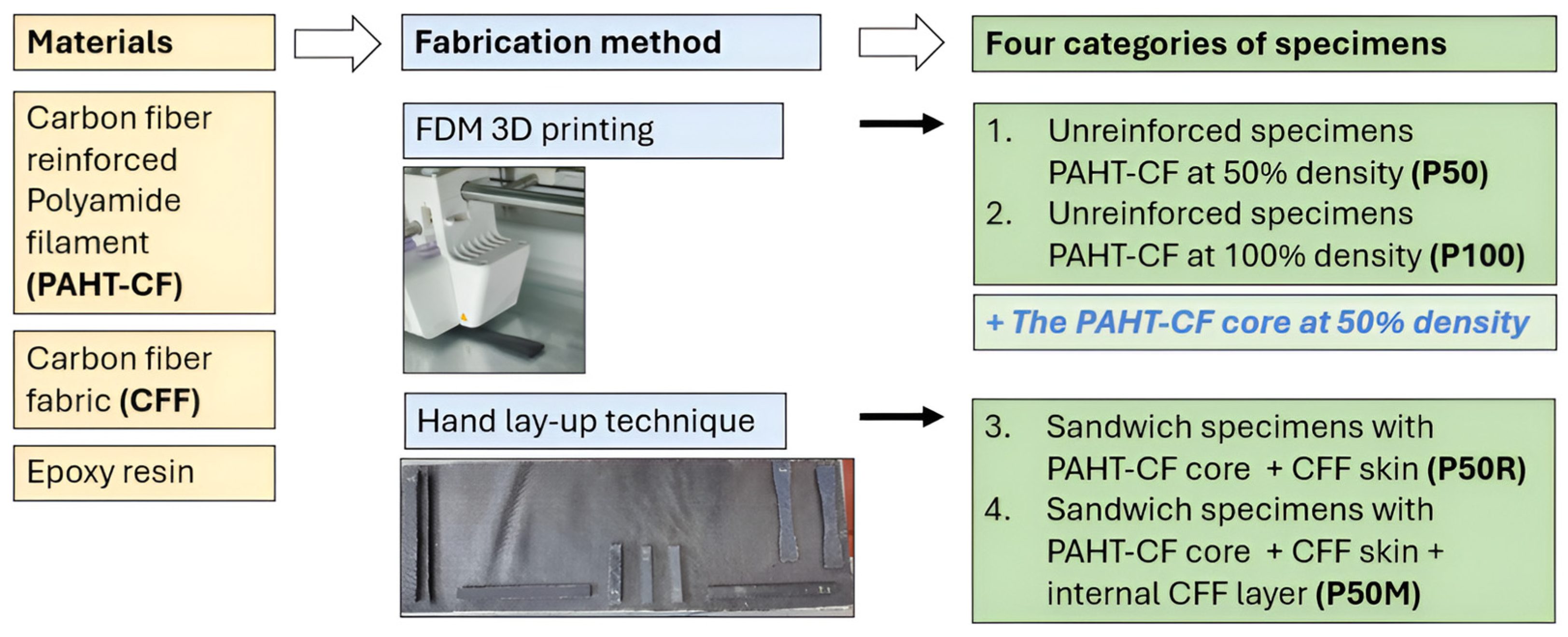

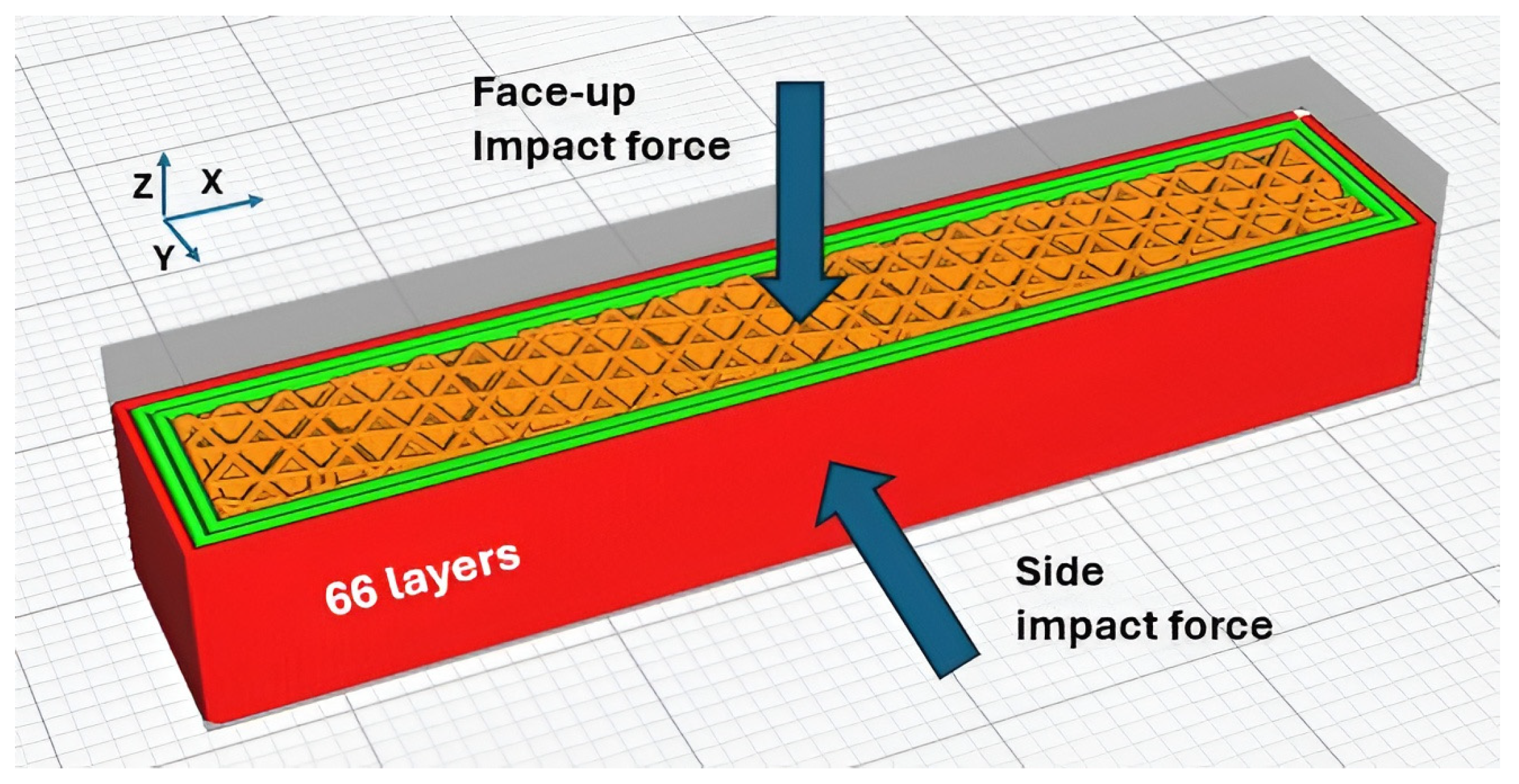

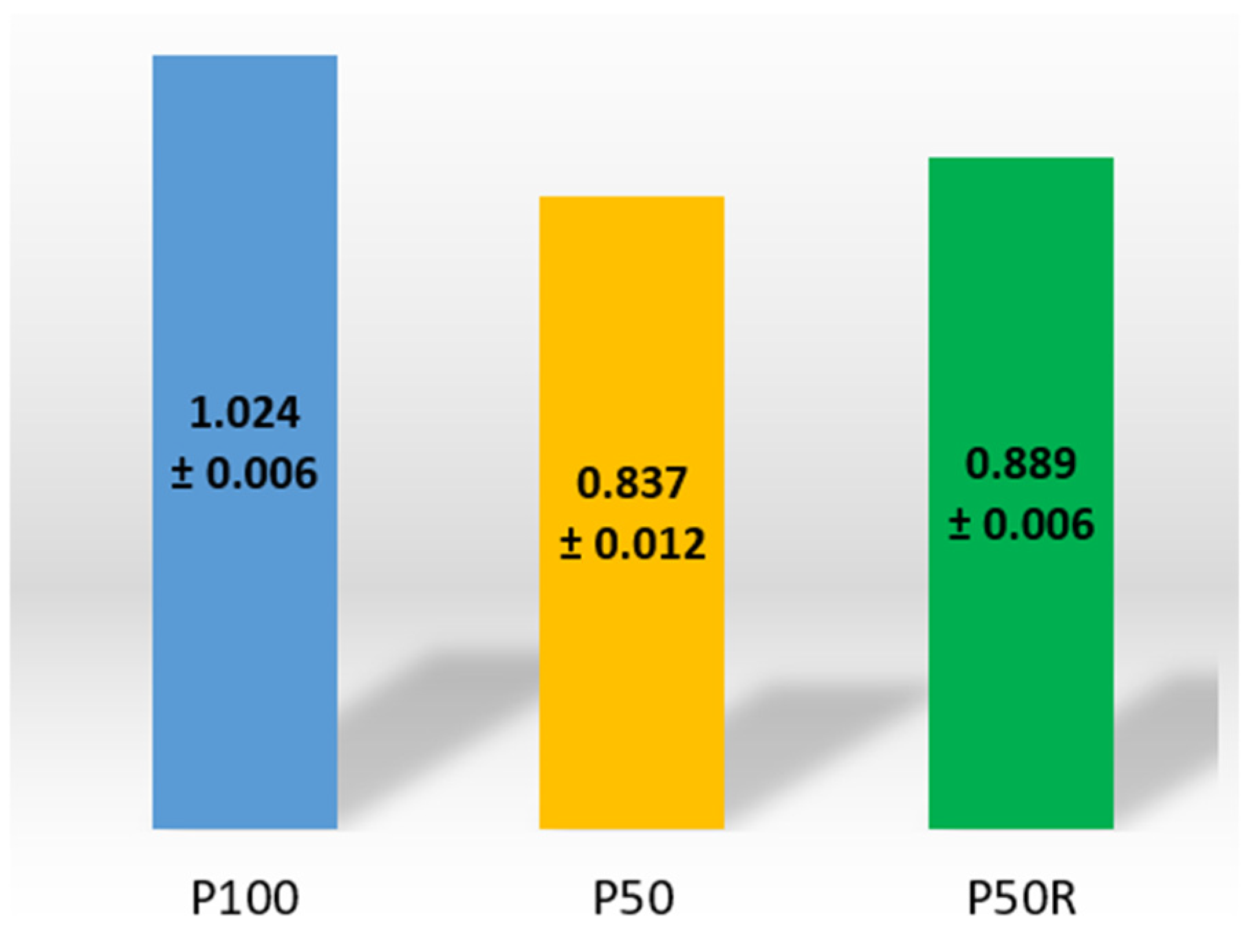

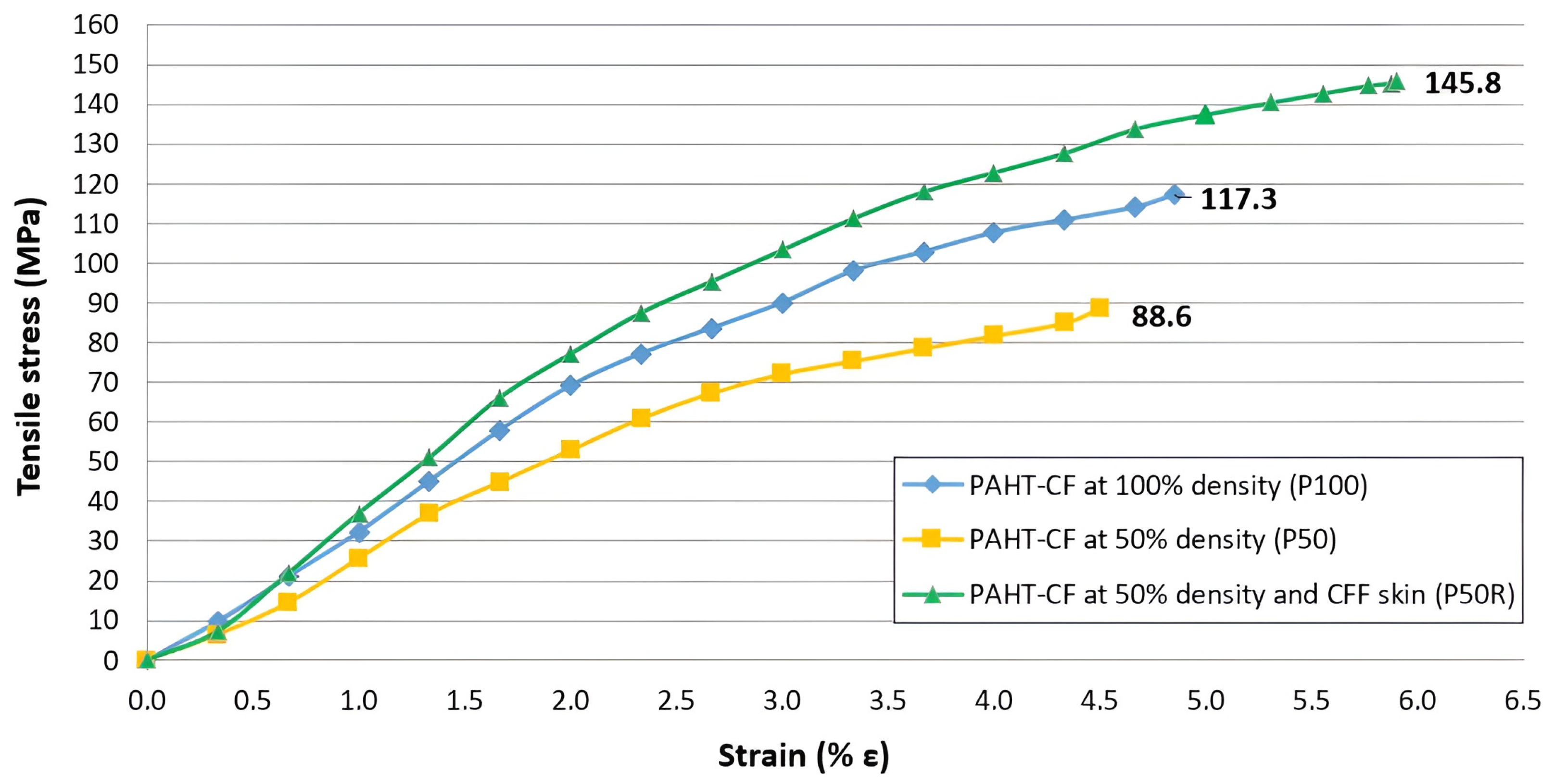
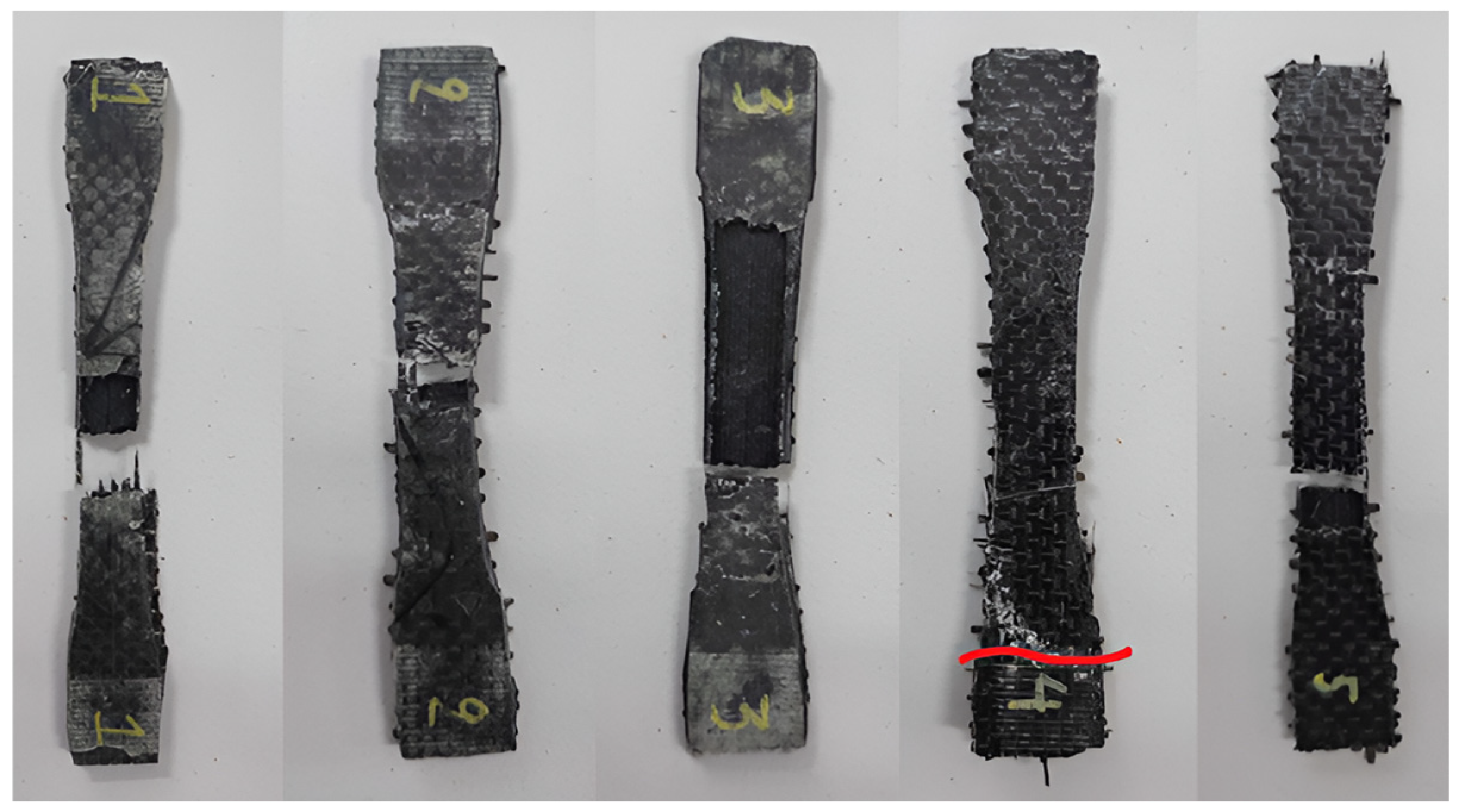
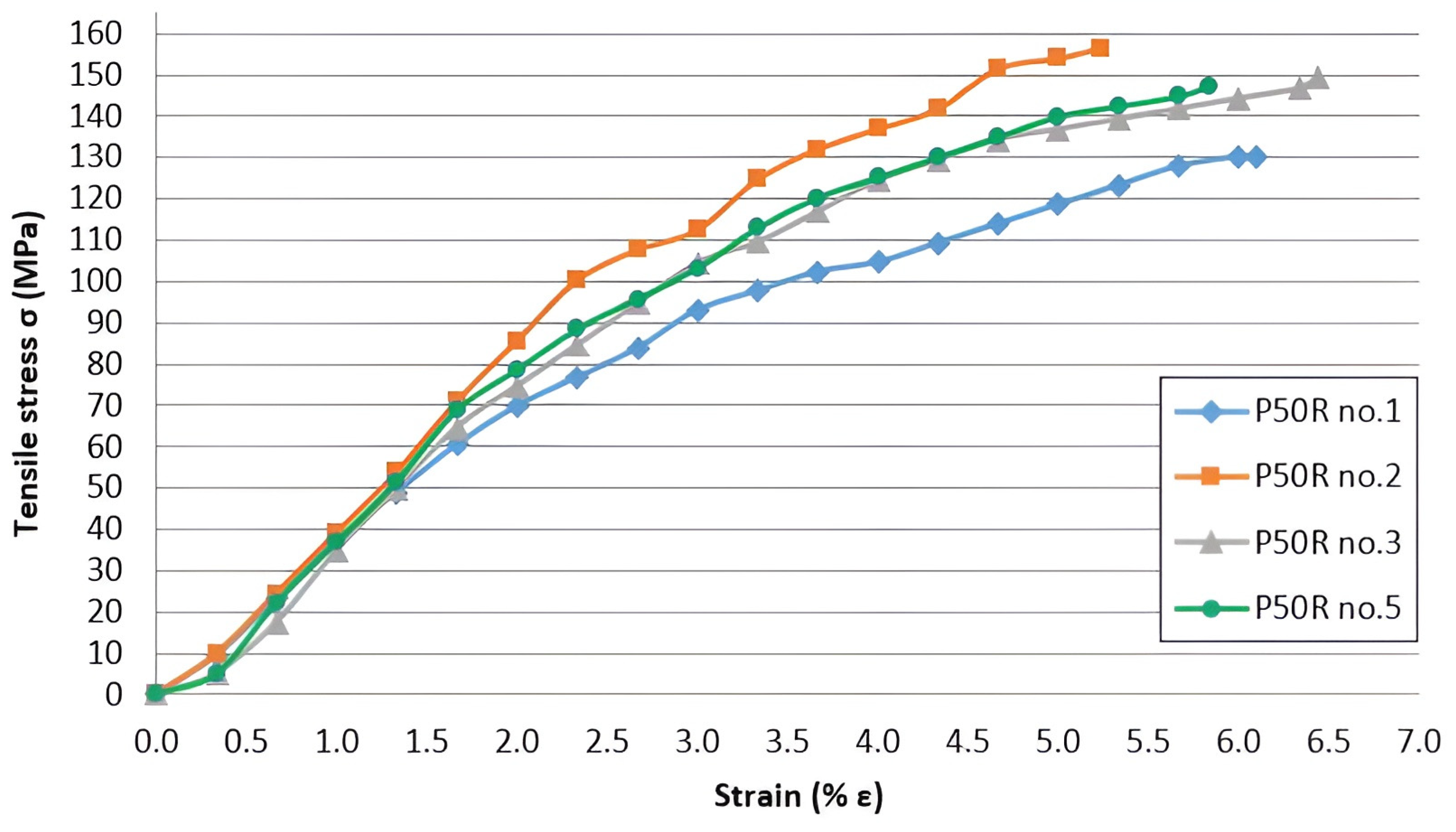

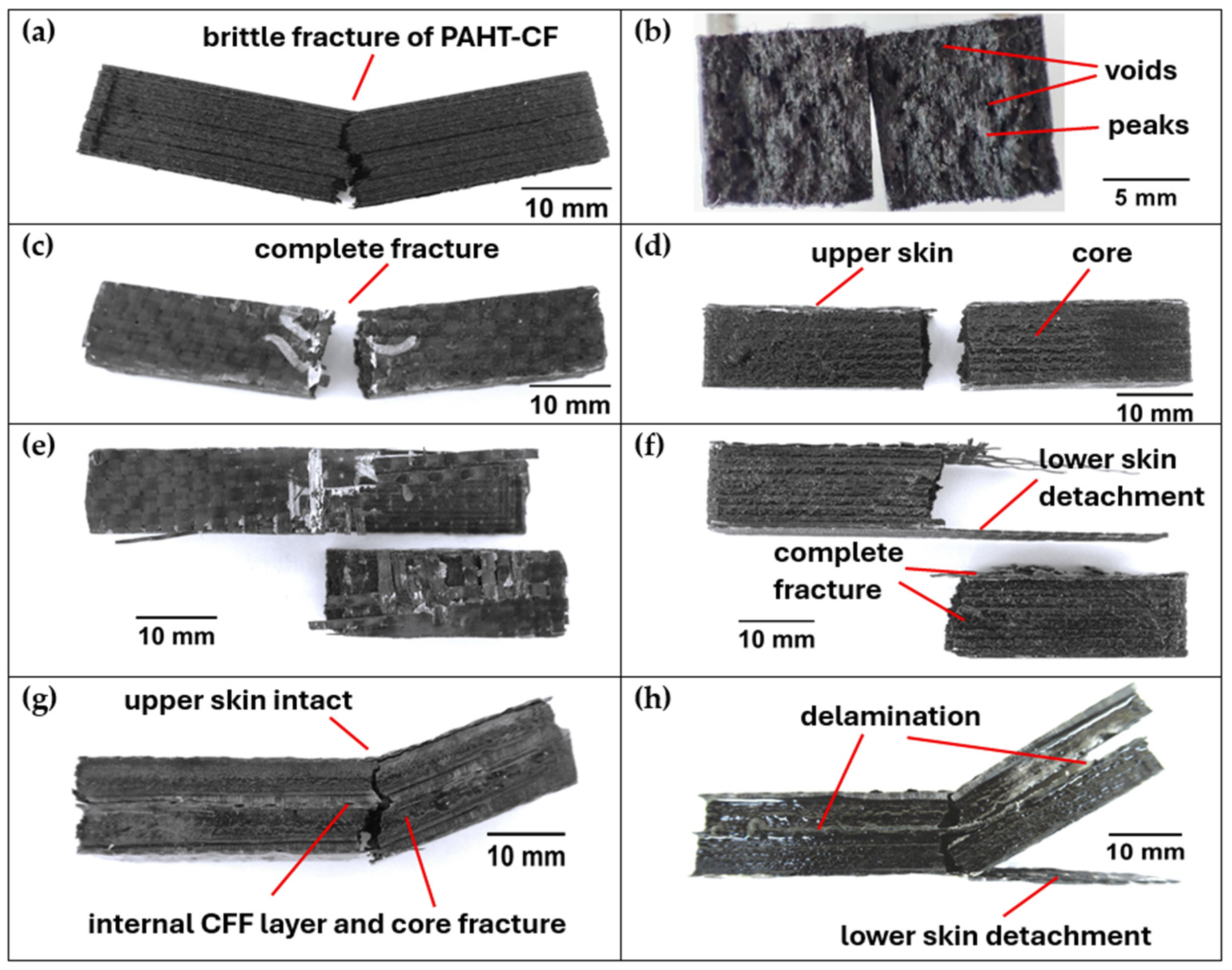
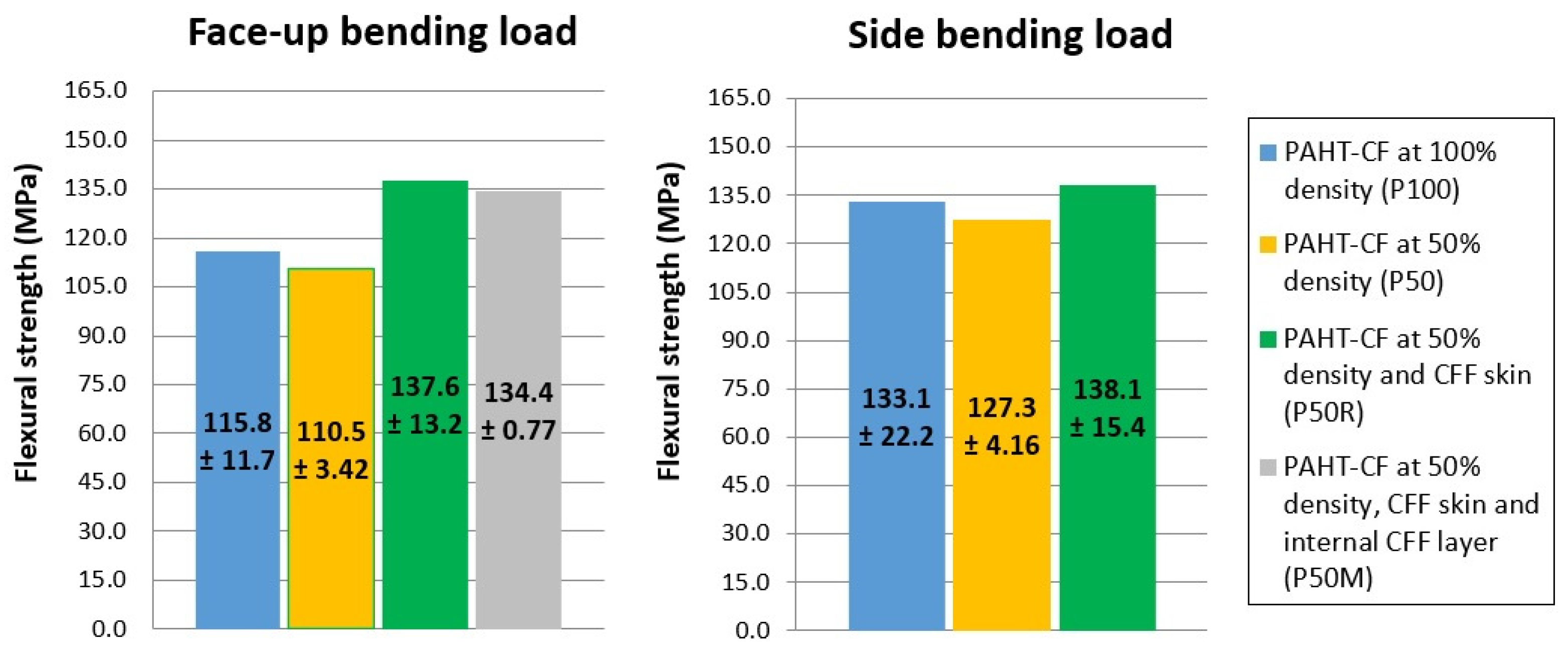


| Printing Parameters | Value |
|---|---|
| Layer height (mm) | 0.15 |
| Initial layer height (mm) | 0.27 |
| Raster width (mm) | 0.58 |
| Number of walls | 3 |
| Wall thickness (mm) | 1.74 |
| Number of top layers | 3 |
| Number of bottom layers | 3 |
| Top/bottom thickness (mm) | 0.9 |
| Build orientation | XY |
| Infill density (%) | 50%, 100% |
| Infill pattern | Lines, Cubic, Concentric |
| Top/bottom layers pattern | Lines, Concentric |
| Infill overlap | 10% |
| Infill flow, top/bottom flow | 100% |
| Print speed (mm/s) | 30 |
| Initial layer speed (mm/s) | 15 |
| Extrusion head type | CC 0.6 mm |
| Nozzle printing temperature (°C) | 270 |
| Build plate temperature (°C) | 100 |
| Raft material | None |
| Infill Pattern | Top/Bottom Pattern | Code | |
|---|---|---|---|
| Lines |  | Lines | P100LL |
| Concentric |  | Concentric | P100OO |
| Cubic |  | Lines | P100CL |
| Concentric | P100CO | ||
| Tensile Properties | Impact Strength (J/cm2) | |||
|---|---|---|---|---|
| Specimens | σmax (ΜPa) | % εmax | Face-Up | Side |
| P100LL | 93.4 ± 0.5 | 5.7 ± 0.3 | - | - |
| P100OO | 127.8 ± 3.4 | 7.0 ± 0.7 | 3.29 ± 0.08 | 2.63 ± 0.11 |
| P100CL | 96.5 ± 13.0 | 6.3 ± 1.0 | 2.65 ± 0.47 | 2.56 ± 0.09 |
| P100CO | 117.3 ± 4.5 | 4.8 ± 0.2 | 1.99 ± 0.16 | 2.51 ± 0.14 |
| Specimens | Length | Width | Thickness |
|---|---|---|---|
| P100LL | 100.39 ± 0.09 | 10.41 ± 0.05 | 3.17 ± 0.01 |
| P100OO | 100.18 ± 0.06 | 10.23 ± 0.04 | 3.06 ± 0.01 |
| P100CL | 100.71 ± 0.01 | 10.48 ± 0.30 | 3.14 ± 0.09 |
| P100CO | 100.31 ± 0.01 | 10.22 ± 0.22 | 3.05 ± 0.01 |
| CAD model | 100.00 | 10.00 | 3.00 |
| Specimens | Mass (g) | Water Absorbed (mg/cm3) | St. Dev. | Water Absorbed (%) | St. Dev. |
|---|---|---|---|---|---|
| P100 | 3.190 | 131.671 | 33.589 | 13.048 | 3.280 |
| P50 | 2.626 | 199.638 | 38.862 | 23.852 | 4.643 |
| P50R | 3.110 | 118.973 | 25.930 | 13.383 | 2.917 |
| Specimens | Surface | Hardness | St. Dev. | n |
|---|---|---|---|---|
| P100 | face-up | 79.1 | 1.8 | 10 |
| P100 | face-down | 79.5 | 3.0 | 10 |
| P100 | side | 71.0 | 2.6 | 10 |
| P50R | face-up | 83.7 | 4.1 | 10 |
| P50R | face-down | 82.3 | 3.6 | 10 |
| Material | Infill Pattern | Tensile Strength | Impact Strength | Flexural Strength | Reference |
|---|---|---|---|---|---|
| PAHT-CF at 100% infill density | lines | 117.1 | [36] | ||
| zig zag (±45°) | 106.6 | [34] | |||
| lines (90°/0°) | ~77.4 | ~162 | [35] | ||
| cubic | 117.3 | 1.99 | 115.8 | this study | |
| PAHT-CF at 50% infill density | lines | 59.4 | 107.6 | [18] | |
| triangles | 59.2 | 108.2 | [18] | ||
| grid | 57.6 | 104.9 | [18] | ||
| cubic | 88.6 | 1.84 | 110.5 | this study |
| Core Material | Skin Material | Manufacturing Process | Flexural Strength (MPa) | Reference |
|---|---|---|---|---|
| PA12 | CFRP | 3D printing/hand lay-up | 2–10 | [51] |
| PEI | CFRP | 3D printing/vacuum bagging | 3.8–34.3 | [7] |
| PLA | CFRP | 3D printing/hand lay-up | 25.46–100.97 | [57] |
| PAHT-CF | CFF | 3D printing/hand lay-up | 137.6 | this study |
Disclaimer/Publisher’s Note: The statements, opinions and data contained in all publications are solely those of the individual author(s) and contributor(s) and not of MDPI and/or the editor(s). MDPI and/or the editor(s) disclaim responsibility for any injury to people or property resulting from any ideas, methods, instructions or products referred to in the content. |
© 2025 by the authors. Licensee MDPI, Basel, Switzerland. This article is an open access article distributed under the terms and conditions of the Creative Commons Attribution (CC BY) license (https://creativecommons.org/licenses/by/4.0/).
Share and Cite
Dimitrellou, S.; Iakovidis, I.; Stratos, G.; Pagonis, D.-N. Experimental Study on Sandwich Composites with Carbon Fiber Fabric Skin and 3D-Printed Carbon Fiber-Reinforced Polyamide Core. J. Manuf. Mater. Process. 2025, 9, 361. https://doi.org/10.3390/jmmp9110361
Dimitrellou S, Iakovidis I, Stratos G, Pagonis D-N. Experimental Study on Sandwich Composites with Carbon Fiber Fabric Skin and 3D-Printed Carbon Fiber-Reinforced Polyamide Core. Journal of Manufacturing and Materials Processing. 2025; 9(11):361. https://doi.org/10.3390/jmmp9110361
Chicago/Turabian StyleDimitrellou, Sotiria, Isidoros Iakovidis, Gerasimos Stratos, and Dimitrios-Nikolaos Pagonis. 2025. "Experimental Study on Sandwich Composites with Carbon Fiber Fabric Skin and 3D-Printed Carbon Fiber-Reinforced Polyamide Core" Journal of Manufacturing and Materials Processing 9, no. 11: 361. https://doi.org/10.3390/jmmp9110361
APA StyleDimitrellou, S., Iakovidis, I., Stratos, G., & Pagonis, D.-N. (2025). Experimental Study on Sandwich Composites with Carbon Fiber Fabric Skin and 3D-Printed Carbon Fiber-Reinforced Polyamide Core. Journal of Manufacturing and Materials Processing, 9(11), 361. https://doi.org/10.3390/jmmp9110361








